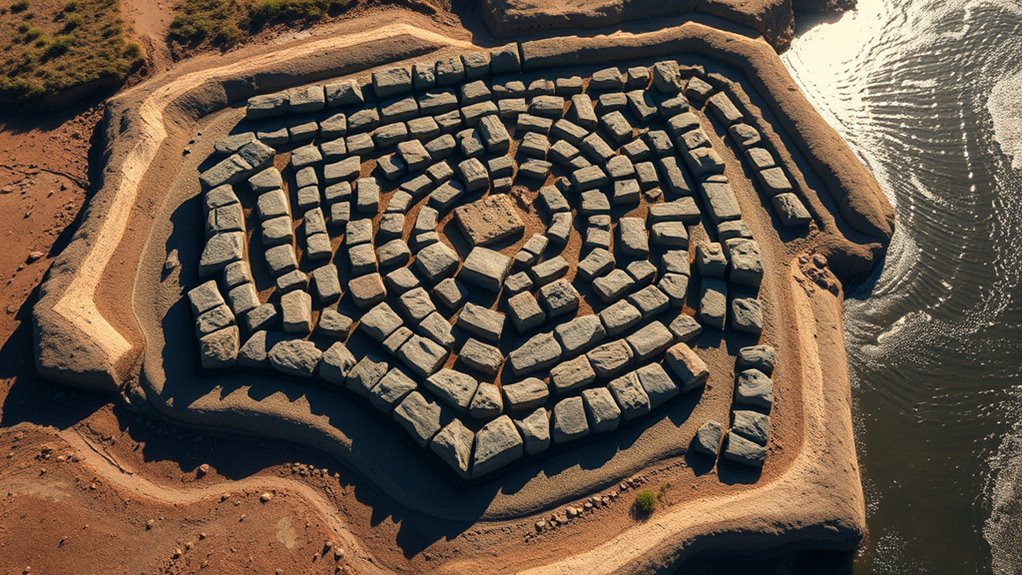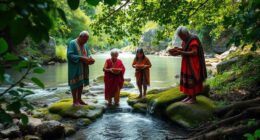The Brewarrina fish traps, built over 6,600 years ago by Indigenous Australians, showcase advanced early aquaculture. You see carefully arranged rocks and branches designed to guide and catch fish sustainably, reflecting an in-depth understanding of water flows and fish behavior. These structures demonstrate respect for the environment and long-term resource management. As you explore further, you’ll discover how these ancient techniques offer valuable lessons in modern water conservation and sustainable fishing practices.
Key Takeaways
- The Brewarrina Fish Traps, built around 6,600 years ago by Indigenous Australians, showcase early sustainable aquaculture practices.
- Constructed with natural materials like rocks and branches, they function as barriers and channels to guide and trap fish.
- Their design reflects a deep understanding of water flow, fish behavior, and environmental management for long-term sustainability.
- They demonstrate cultural respect for water sources and resource conservation, supporting thriving communities over millennia.
- The traps serve as a modern example of sustainable fishing techniques, emphasizing harmony with natural ecosystems.

Have you ever wondered how ancient civilizations managed to sustain their populations with reliable food sources? One fascinating example is the Brewarrina fish traps, which date back approximately 6,600 years. These incredible structures demonstrate early ingenuity in aquaculture, showcasing how communities harnessed natural resources for food and survival. The fish traps, built by Indigenous Australians, are a proof of traditional fishing techniques that relied on understanding local water flows and fish behaviors. Instead of modern equipment, ancient fishers used natural materials like rocks and branches to create barriers and channels that guided fish into designated areas for easy catching. These traps weren’t just accidental; they were carefully designed and maintained, reflecting a deep knowledge of the environment and fish migration patterns. Their environmental knowledge was essential for their success and longevity. Using traditional fishing techniques, they effectively managed their catches without overfishing or damaging the ecosystem. They understood the importance of respecting water sources, which led to the development of water conservation methods. For example, by constructing the traps in strategic locations, they minimized waste and ensured a steady food supply over generations. These methods helped sustain large populations and allowed communities to thrive in an environment where resources could be scarce or unpredictable. Their water conservation practices weren’t limited to fishing; they also included managing water flow and preserving water quality, ensuring the traps remained functional for centuries. Their approach exemplifies a sustainable model, balancing human needs with environmental health.
What’s remarkable is that these ancient techniques are still relevant today. Modern aquaculture often looks to history for lessons on sustainability and resource management. The Brewarrina fish traps highlight how ingenuity, combined with respect for nature, can create effective food systems. Their success depended on a profound understanding of water cycles, fish behavior, and local ecosystems—principles that remain crucial in contemporary water conservation and sustainable fishing practices. By studying these early methods, we recognize that sustainable aquaculture doesn’t require complex technology; sometimes, it’s about working in harmony with natural processes. This ancient innovation offers valuable insights into how we can better manage our water and fisheries today, ensuring food security for future generations while preserving the environment.
Frequently Asked Questions
How Were the Fish Traps Originally Constructed and Maintained?
You might wonder how the fish traps were originally built and maintained in good shape. They used simple construction techniques, stacking rocks and stones to create barriers in the river. Maintenance practices involved regular repositioning and adding stones to repair damage caused by water flow or weather. This ongoing upkeep ensured the traps remained effective for catching fish, demonstrating the ingenuity and sustainability of ancient construction methods.
What Specific Fish Species Were Targeted by the Traps?
You might wonder which fish species the traps targeted. The trap design was specifically crafted to catch species following seasonal fish migration patterns, primarily native species like catfish, bream, and mullet. These fish migrate along the river at certain times of the year, making the traps highly effective. By understanding fish migration, you see how the trap design optimized catch efficiency and sustained the community’s food supply over thousands of years.
How Did the Traps Influence Local Ecology and Biodiversity?
This question might seem simple, but the ecological impact of the Brewarrina fish traps is immense. You see, they boosted biodiversity benefits by creating a sustainable fish population, supporting various species and strengthening the ecosystem. These ancient traps helped maintain a balanced environment, preventing overfishing and encouraging diverse aquatic life. Their influence was like a shield, protecting and nurturing the local ecology for thousands of years, shaping a thriving habitat.
Were Similar Ancient Aquaculture Techniques Used Elsewhere Globally?
You might wonder if ancient fishing and water management techniques like the Brewarrina fish traps were used elsewhere globally. Many cultures, such as the Chinook in North America and the Nilotic peoples in Africa, employed similar methods to catch fish and control water flow. These techniques demonstrate how ancient societies adapted their environments, showcasing innovative aquaculture practices that influenced local ecosystems and supported sustainable resource use worldwide.
What Cultural or Spiritual Significance Do the Traps Hold?
You can see that the traps hold deep cultural and spiritual significance, serving as sacred sites for spiritual ceremonies. They connect communities to their ancestors and reinforce cultural heritage, highlighting the importance of respecting traditions. The fish traps are more than just tools; they symbolize a spiritual bond to the land and water, reminding you of the enduring connection between people, nature, and spiritual practices.
Conclusion
As you imagine the Brewarrina fish traps, think of them as ancient guardians of water and life—like silent sentinels watching over a timeless river. Their 6,600-year story whispers of human ingenuity, much like the eternal flow of the river itself. These traps remind you that even in primitive designs, there’s a profound mastery that connects us to our ancestors and the enduring pulse of nature. Their legacy flows on, shaping history like an unending current.









